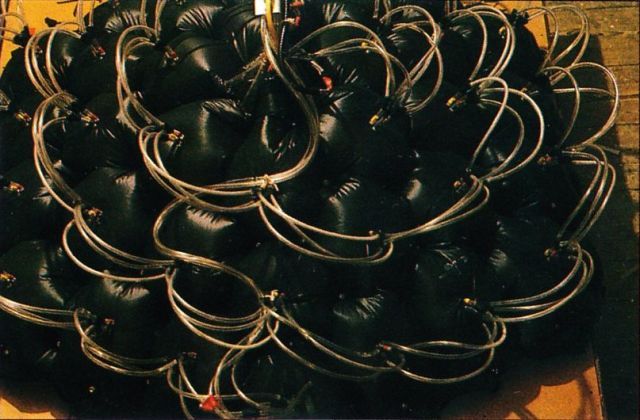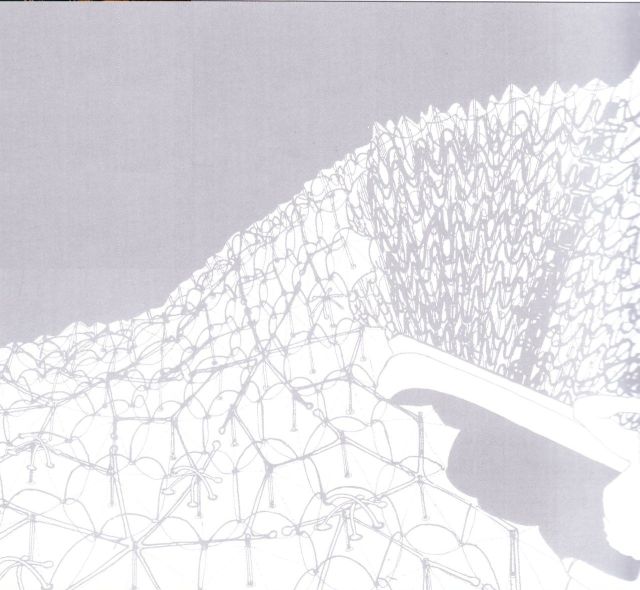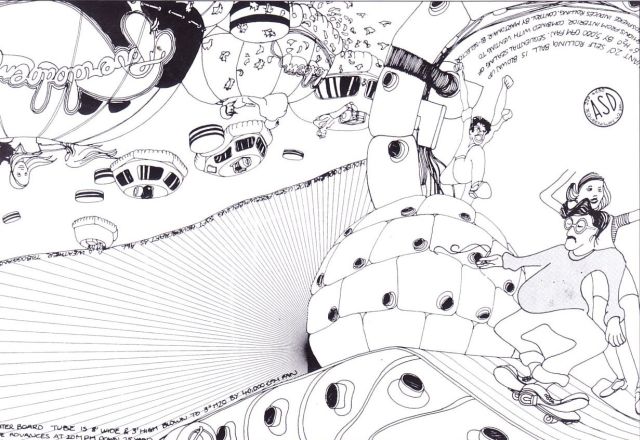


Source: Mark Fisher: staged architecture by Eric Holding – 2000
Inflatables and Structures
Fisher had seen his first anthropomorphic inflatable Mother of the Arts in 1966. It was an inflatable woman designed by fellow Architectural Association students for the annual Lord Mayor's procession. It was based on Jean Tinguely's She, a long, hollow reclining woman whose vagina was the entrance to the exhibition inside shown earlier that year at Stockholm's Moderna Museet. In the procession, the designers of Mother of the Arts wielded coloured marker pens on the inner surface of the clear polythene blow-up.
Four years later Fisher and Simon Conolly built a 14-metre- (46-ft-) long inflatable submarine which toured on the back of a flatbed truck and featured at several exhibitions. In 1969 they had set up the firm, Air Structures Design, as a commercial vehicle for making lightweight tents and inflatables; the profits from this financed their student work on an inflatable mat which could be configured in a number of ways as a rigid structure. An interim version, Automat. was exhibited at the 1969 Paris Biennale and the two submitted a final version as their final year thesis project. Dynamat was a muti-celled inflatable structure which could be bent and shaped by varying the air pressure in each cell.
……
The success of Woodstock inspired many similar events such as the Isle of Wight Festival, for which Fisher helped build the stage structure designed by the engineer Anthony Hunt. Inevitably through his own direct experience of attending events like this, and given the powerful influence of Archigram, Fisher's work reflected the spirit of the times, which is apparent in his designs for an Adult Theme Park carried out in 1970. The drawings, which have a loose playful quality, depict a youthful population exercising its right to hedonistic behaviour, and inhabiting an artificial entertainment landscape, complete with hover-dodgems, disposable hot air balloons, bouncy floors, and escape towers.
It is interesting to observe the emphasis placed on technology in this scheme — and in the work of Archigram — which can be seen as a response to the advances that were taking place during the 1960s, such as the Apollo space programme, Sea-Lab, the introduction of the hovercraft and the Boeing 707. Whilst many of these technological developments were a direct result of cold war research programmes, they were all perceived to extend the capabilities of mankind, and as a result technology was seen as a form of social emancipation which was to be embraced. Rock music itself depended upon new technology, not just for the amplification of instruments and the emergence of the electric guitar, but also for the advent of television which played a significant role in its rapid rise in popularity.
Fisher's fascination with technology is manifest in his Automat project of 1968, which he carried out in collaboration with fellow student David Harrison. The liberal pedagogical stance assumed by the Architectural Association at this time meant that they were positively encouraged to develop their own approach to architectural design, and as a result the project emerged out of a sustained period of practical experimentation. Automat was an attempt to create a self-articulating form which altered shape in response to its users' changing physical requirements. In order to achieve this they created a rudimentary low-pressure pneumatic structure which was articulated using a system of internal bracing cables connected to high-pressure jacks which could selectively expand or contract the structure at a ratio of 80:1. Although some problems were encountered with fabrication, the structure was exhibited at the Paris Biennale in I969, and the project was featured in Peter Cook's publication Experimental Architecture in 1970.
The work of one member of the Archigram1 group, Mark Fisher, a student of Peter Cook at the Architectural Association (AA) in London, embraced the language and images of the youth culture that was booming in England and abroad. His investigations into inflatable technology led to the Automat in 1968-9. It was a user-responsive pneumatic structure supported by internal bracing cables, which, attached to high pressure jacks, allowed the structure to expand and contract in response to a user's weight requirements. Fisher improved the Automat in his design of the Dynamat, the surface of which was controlled by a series of valves which open and closed in in pre-programmed sequences.
1Archigram was a publication, begun in 1961, that quickly became known for its alternative ideas. Short for "Architectural Telegram," Archigram was produced by the young English architects Peter Cook, David Greene, Michael Webb, Ron Herron, Warren Chalk, and Dennis Crompton. The full Archigram group later included Colin Fournier, Ken Allison, and Tony Rickaby.